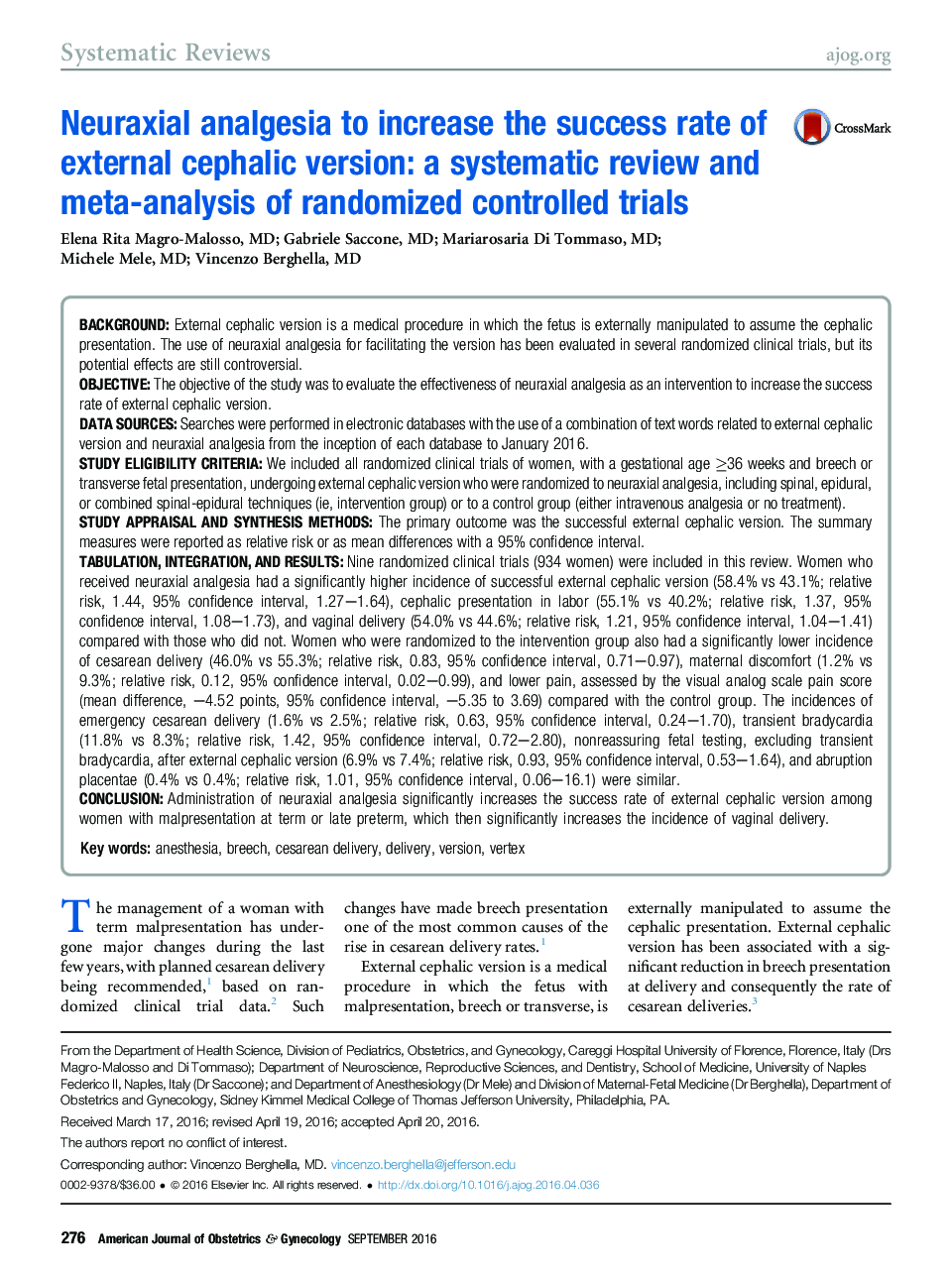| کد مقاله | کد نشریه | سال انتشار | مقاله انگلیسی | نسخه تمام متن |
|---|---|---|---|---|
| 3432112 | 1594886 | 2016 | 11 صفحه PDF | دانلود رایگان |
BackgroundExternal cephalic version is a medical procedure in which the fetus is externally manipulated to assume the cephalic presentation. The use of neuraxial analgesia for facilitating the version has been evaluated in several randomized clinical trials, but its potential effects are still controversial.ObjectiveThe objective of the study was to evaluate the effectiveness of neuraxial analgesia as an intervention to increase the success rate of external cephalic version.Data SourcesSearches were performed in electronic databases with the use of a combination of text words related to external cephalic version and neuraxial analgesia from the inception of each database to January 2016.Study Eligibility CriteriaWe included all randomized clinical trials of women, with a gestational age ≥36 weeks and breech or transverse fetal presentation, undergoing external cephalic version who were randomized to neuraxial analgesia, including spinal, epidural, or combined spinal-epidural techniques (ie, intervention group) or to a control group (either intravenous analgesia or no treatment).Study Appraisal and Synthesis MethodsThe primary outcome was the successful external cephalic version. The summary measures were reported as relative risk or as mean differences with a 95% confidence interval.Tabulation, Integration, and ResultsNine randomized clinical trials (934 women) were included in this review. Women who received neuraxial analgesia had a significantly higher incidence of successful external cephalic version (58.4% vs 43.1%; relative risk, 1.44, 95% confidence interval, 1.27–1.64), cephalic presentation in labor (55.1% vs 40.2%; relative risk, 1.37, 95% confidence interval, 1.08–1.73), and vaginal delivery (54.0% vs 44.6%; relative risk, 1.21, 95% confidence interval, 1.04–1.41) compared with those who did not. Women who were randomized to the intervention group also had a significantly lower incidence of cesarean delivery (46.0% vs 55.3%; relative risk, 0.83, 95% confidence interval, 0.71–0.97), maternal discomfort (1.2% vs 9.3%; relative risk, 0.12, 95% confidence interval, 0.02–0.99), and lower pain, assessed by the visual analog scale pain score (mean difference, –4.52 points, 95% confidence interval, –5.35 to 3.69) compared with the control group. The incidences of emergency cesarean delivery (1.6% vs 2.5%; relative risk, 0.63, 95% confidence interval, 0.24–1.70), transient bradycardia (11.8% vs 8.3%; relative risk, 1.42, 95% confidence interval, 0.72–2.80), nonreassuring fetal testing, excluding transient bradycardia, after external cephalic version (6.9% vs 7.4%; relative risk, 0.93, 95% confidence interval, 0.53–1.64), and abruption placentae (0.4% vs 0.4%; relative risk, 1.01, 95% confidence interval, 0.06–16.1) were similar.ConclusionAdministration of neuraxial analgesia significantly increases the success rate of external cephalic version among women with malpresentation at term or late preterm, which then significantly increases the incidence of vaginal delivery.
Journal: American Journal of Obstetrics and Gynecology - Volume 215, Issue 3, September 2016, Pages 276–286
